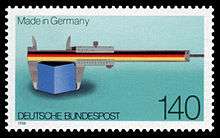Made in Germany

Made in Germany is a merchandise mark indicating that a product has been manufactured in Germany.
History
The label was originally introduced in Britain by the Merchandise Marks Act 1887,[1] to mark foreign produce more obviously, as foreign manufactures had been falsely marking inferior goods with the marks of renowned British manufacturing companies and importing them into the United Kingdom. Most of these were found to be originating from Germany, whose government had introduced a protectionist policy to legally prohibit the import of goods in order to build up domestic industry (Merchandise Marks Act - Oxford University Press).[2]
According to Professor Asaf Zussman, Department of Economics, Hebrew University in "The Rise of German Protectionism in the 1870s: A Macroeconomic Perspective∗", the "Rye and Iron" tariffs introduced by Bismarck’s Germany in 1879 caused a major reduction of imports in order to protect Germany's industries. As a response, the Free-trade Liberal government in the UK introduced the Merchandise Marks act to allow consumers to be able to choose whether or not they would continue to purchase goods from protectionist economies.
Germany successfully leveraged the Made in Germany tag as a brand synonymous of product reliability and quality.[3][4][5][6][7]
"Made in Germany" is not controlled by a central regulatory body. However, its status has been defined by several court rulings in Germany. In 1973, the Bundesgerichtshof made a ruling that Made in Germany does not enable people to properly distinguish between the two Germanys of the time, so Made in West Germany and Made in GDR became popular. In 1995, the Oberlandesgericht Stuttgart ruled that the term Made in Germany is misleading according to Germany's Fair Trades Act when the largest part is not German raw materials or German craftsmanship.
See also
References
- ↑ "Board of Trade: Merchandise Marks Standing Committee: Papers". The National Archives (United Kingdom). Retrieved 2012-10-20.
The Merchandise Marks Act 1887 required, for the first time, that the country of origin should be marked on any imported goods bearing the name or trade mark of a United Kingdom manufacturer. . . . Under the Act, the addition of the country of origin to imported goods of any series or description could be enforced by Order in Council.
- ↑ "Dreist, dreister, Deutschland". Spiegel Online. Retrieved 24 August 2012.
- ↑ "How much is 'Made in Germany' really worth?". Deutsche Welle. 20 January 2014.
- ↑ "Tighter 'Made in Germany' rules criticised". The Local. 16 Jan 2012.
- ↑ "Unpopular EU Proposal: 'Made in Germany' Label At Risk". Speigel Online. January 16, 2012.
- ↑ "'Made in Germany' in times of globalisation".
- ↑ A. Joseph, Ugesh. "The 'Made in Germany' Champion Brands" (PDF). GOWER.
Further reading
- Borck, Hans-Günther (1993). Ein gemeinsames Erbe: "Made in Germany". Wettbewerb in Recht und Praxis. pp. 301–303.
- Wulf, Julia (1995). "Made in Germany": Wirtschaftliche Bedeutung und rechtliche Schutzmöglichkeiten. Frankfurt am Main; New York: Peter Lang Verlag. ISBN 3-631-47785-6.
- Jenkins, Steve (2016). "Is my 'Made in Germany' (or West Germany) SIG Really German?". Seattle, Washington: RealGunReviews.com.